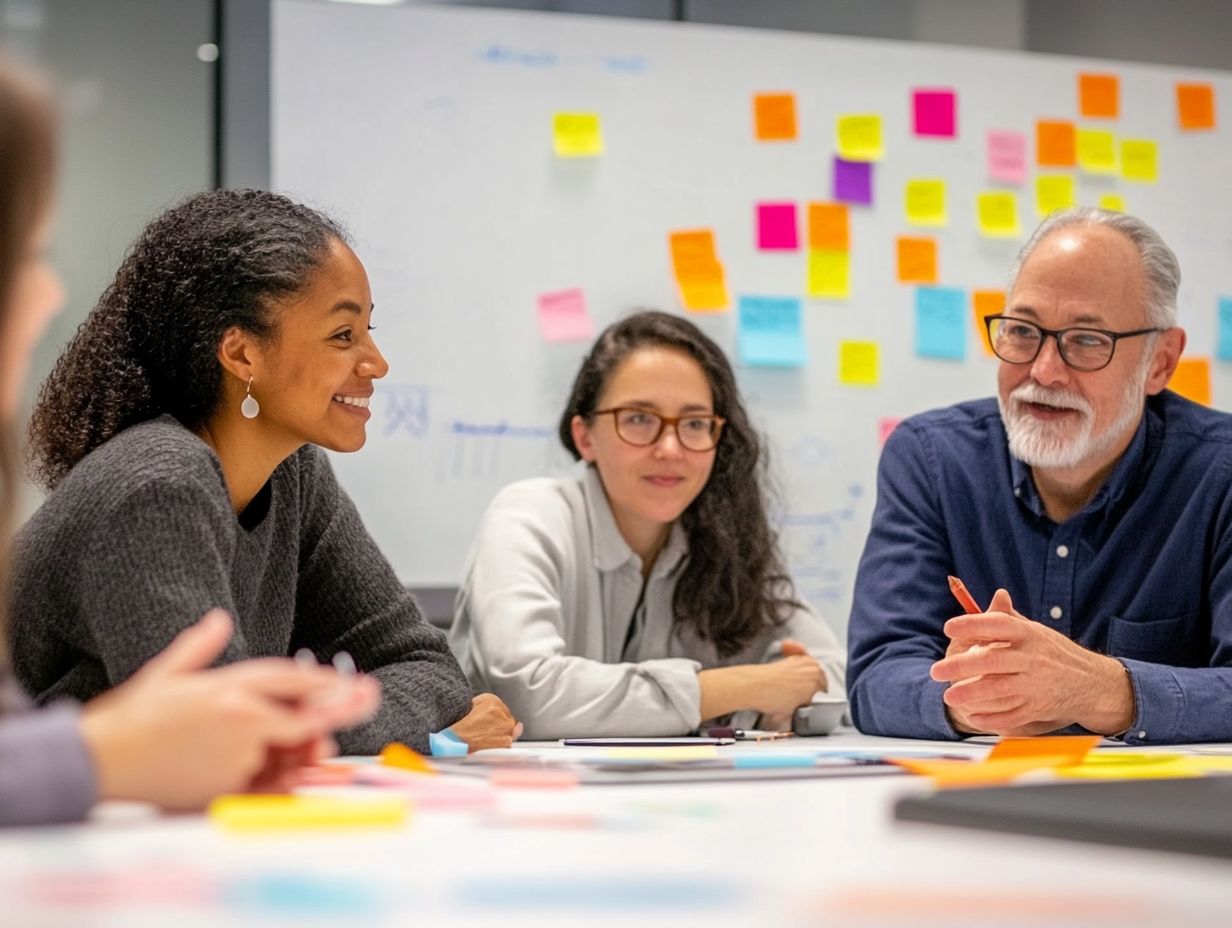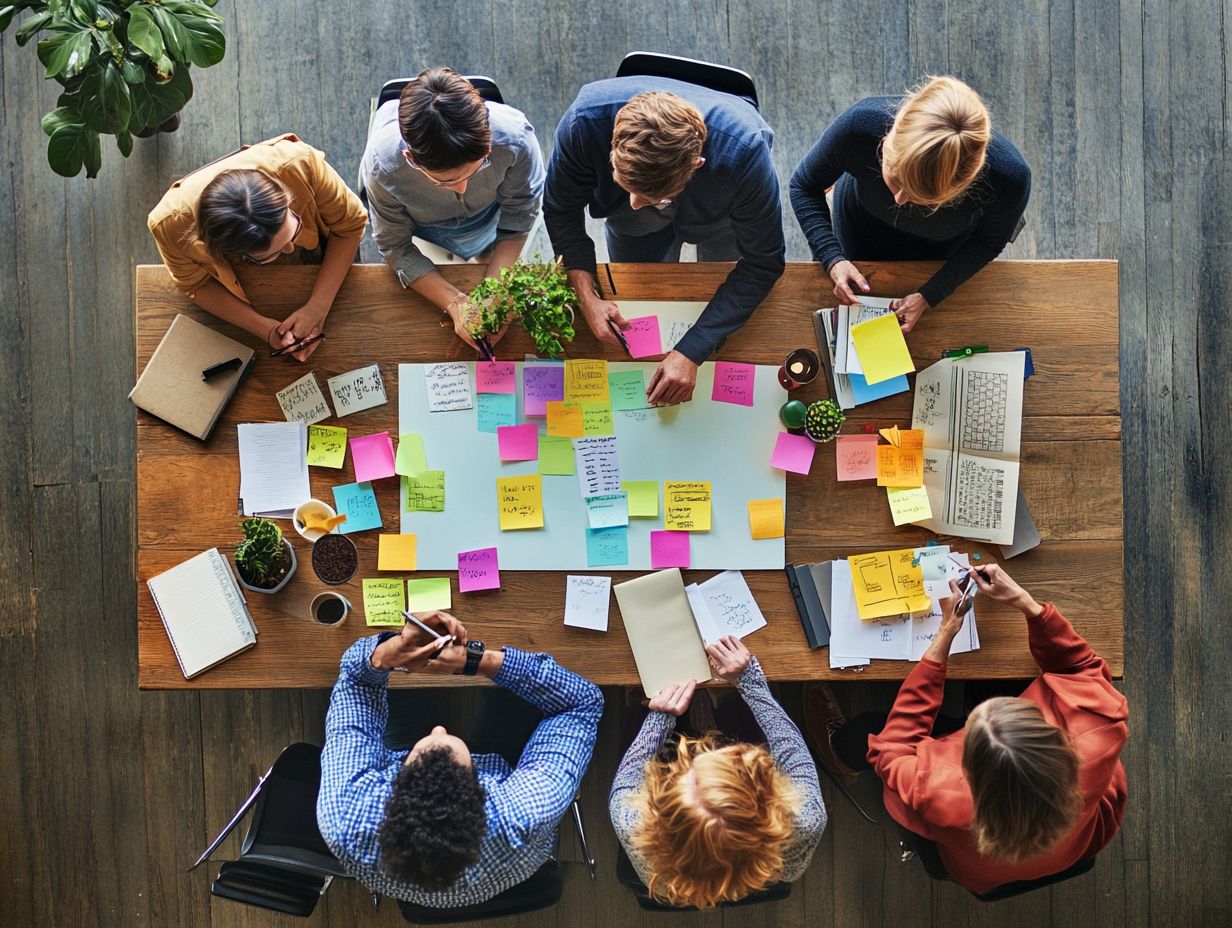FAQs on Effective Brainstorming Sessions
Brainstorming transcends mere creative jargon; it s a vibrant process that ignites innovation and fosters collaboration.
This article delves into the genuine essence of brainstorming, highlighting its myriad benefits and providing insights on how to conduct effective sessions that generate actionable ideas. From establishing clear goals and guidelines to navigating common challenges, you ll be guided through every step of the brainstorming journey.
This article answers frequently asked questions to help you brainstorm productively.
Dive in and unleash your creative power today!
Contents
- Key Takeaways:
- What is Brainstorming?
- Benefits of Effective Brainstorming
- Preparing for a Brainstorming Session
- Conducting an Effective Brainstorming Session
- Common Challenges and How to Overcome Them
- Evaluating and Implementing Ideas from a Brainstorming Session
- Filtering and Prioritizing Ideas
- Frequently Asked Questions about Brainstorming
- Answers to Common Queries and Concerns
- Frequently Asked Questions
- What is a brainstorming session and why is it important?
- How do I prepare for an effective brainstorming session?
- What are some key factors to consider when facilitating a brainstorming session?
- What are some techniques to enhance creativity during a brainstorming session?
- How do I ensure that all ideas are heard and considered during a brainstorming session?
- What should I do after a brainstorming session to ensure the ideas are implemented?
Key Takeaways:

- Effective brainstorming leads to improved creativity and problem-solving skills.
- Setting clear goals and guidelines is essential for a productive brainstorming session.
- Dealing with group dynamics and roadblocks is a common challenge in brainstorming, but can be overcome through communication and open-mindedness.
What is Brainstorming?
Engaging in brainstorming is a creative process designed to cultivate a rich array of ideas and innovative solutions within a collaborative environment. This technique invites you to immerse yourself in free-thinking while adhering to essential ground-rules, creating a comfortable atmosphere where everyone feels safe to share ideas.
Whether it’s in a team activity, a focused brainstorming meeting, or through online platforms like Mural and Lucidspark, the objective remains the same: to foster effective outcomes that tackle specific topics or problems while ensuring that every voice is heard and valued.
This inclusive approach not only enhances creativity but also strengthens team cohesion.
Definition and Purpose
The definition of brainstorming presents a structured yet adaptable approach to problem-solving, focusing on the generation of ideas often within a designated timeframe.
Your primary objectives with this technique are to enhance creativity and foster collaboration among participants, allowing a rich tapestry of diverse perspectives to emerge. For instance, employing mind mapping can significantly elevate your creative thinking by visually organizing thoughts around a central concept. Alternatively, the Round Robin method ensures that every voice is heard, giving quieter members the encouragement they need to contribute.
By tailoring these techniques to meet the specific needs of your session perhaps by incorporating theme-based prompts for a marketing team you can cultivate innovative strategies that resonate deeply with your target audience.
Benefits of Effective Brainstorming
The benefits of effective brainstorming elevate not just team collaboration but also significantly enhance the quality of ideas that emerge during sessions focused on creative problem-solving.
Improved Creativity and Problem Solving
Engaging in structured brainstorming techniques can significantly enhance your creativity and problem-solving skills, providing a platform that encourages the free flow of ideas.
These methods create a nurturing environment where diverse thoughts can thrive, allowing you to share without the worry of being judged. Techniques like mind mapping and the round-robin approach not only spark your individual creativity but also promote collaboration, resulting in innovative solutions. Utilizing tools such as sticky notes or virtual brainstorming platforms can further amplify your idea generation.
To measure the effectiveness of these sessions, consider tracking metrics like:
- Idea quality
- Quantity generated
- Participant engagement
This approach ensures that every brainstorming effort is both productive and enriching.
Preparing for a Brainstorming Session

Preparing for a brainstorming session requires you to meticulously craft an agenda that outlines clear goals, establishes ground rules, and sets expectations for all participants.
This thoughtful preparation ensures that the environment remains focused and productive, paving the way for innovative ideas to flourish.
Ready to elevate your brainstorming sessions? Start implementing these techniques now!
Setting Goals and Guidelines
Setting clear goals and guidelines is essential for crafting a structured brainstorming framework that enhances participation and sparks idea generation.
When you understand the objectives behind the brainstorming session, you re more inclined to share valuable insights that align with those aims. Establishing specific guidelines clarifies expectations and creates a safe environment where everyone feels at ease expressing their thoughts.
This organized approach encourages a variety of perspectives, ensuring that every voice is heard and contributes to a richer pool of ideas. By aligning these goals with the broader project objectives, you reinforce their importance, motivating participants to engage actively and collaboratively.
Conducting an Effective Brainstorming Session
Conducting an effective brainstorming session demands a deliberate approach. You should harness a variety of techniques and tools to foster engaging discussions. This thoughtful methodology ignites creativity and inspires innovative ideas that can transform your projects.
Techniques and Tips for Productive Brainstorming
Utilizing various brainstorming techniques can significantly boost the productivity of your sessions, paving the way for more effective idea generation and collaboration.
By exploring methods tailored to your group s dynamics, you can cultivate an inclusive atmosphere that encourages creativity. Take mind mapping, for example; it allows you to visually connect various concepts, organizing your thoughts and making it easier to spot correlations.
The round-robin technique ensures equal participation, giving each member the chance to share ideas in a structured way. This approach prevents dominant voices from overshadowing the quieter ones.
Then there’s SCAMPER, your handy checklist for innovation. It prompts you to substitute, combine, or adapt existing ideas to carve out unique solutions. You can effortlessly integrate these techniques into both in-person gatherings and virtual meetings, ensuring that every participant feels valued and engaged, no matter the format.
Common Challenges and How to Overcome Them
Common challenges in brainstorming sessions, like group dynamics and roadblocks, can significantly hinder effectiveness and stifle creative solutions.
Identifying these challenges is the first step to unleashing your team’s creativity! Recognizing these obstacles allows you to navigate them skillfully and unlock the full potential of your team s creative ideas.
Dealing with Group Dynamics and Roadblocks

Navigating group dynamics and overcoming roadblocks is vital for cultivating a vibrant brainstorming culture that invites participation and nurtures the free flow of ideas.
Recognizing that each person brings unique perspectives and communication styles to the table can elevate your brainstorming sessions. It s essential to understand how group dynamics can enhance collaboration or stifle participation.
To ensure that everyone feels valued and has a voice, establishing clear ground rules for discussions is crucial. Strategies such as anonymous suggestion boxes or round-robin sharing can encourage equitable contributions from all team members.
By fostering an inclusive atmosphere where diverse ideas are celebrated, you enable your team to tap into unique insights. Encouraging active listening and validating everyone s input can transform a session into a dynamic environment, ultimately paving the way for more innovative outcomes.
Evaluating and Implementing Ideas from a Brainstorming Session
Evaluating and implementing the ideas that emerge from a brainstorming session is essential for turning diverse concepts into actionable solutions that resonate with your organizational goals.
This process harnesses creativity and ensures that your strategic objectives are met effectively.
Now that you ve learned these techniques, it s time to put them into practice in your next brainstorming session!
Filtering and Prioritizing Ideas
Filtering and prioritizing ideas after a brainstorming session is crucial. This ensures that only the most viable and impactful concepts are selected for implementation.
This process ignites your team’s focus and boosts productivity. It directs resources toward ideas that align seamlessly with your main goals. One effective way to evaluate these ideas is through the Eisenhower Matrix. This tool helps you categorize them based on urgency and importance, providing a clear visual representation of your priorities.
Incorporating voting systems fosters broader team engagement. It allows everyone to express their opinions on which concepts have the most potential. Aligning these selected ideas with your main goals ensures they contribute effectively to your organization’s vision.
Transforming these selected concepts into actionable plans with clear steps and deadlines paves the way for successful execution and tangible results.
Frequently Asked Questions about Brainstorming
Frequently asked questions about brainstorming typically focus on techniques, effectiveness, and strategies for engagement. This reflects a keen interest in elevating creative teamwork and maximizing collaborative potential.
Answers to Common Queries and Concerns
Answers to common queries about brainstorming underscore the significance of structured approaches in enhancing team collaboration and idea generation.
Implementing specific techniques, such as mind mapping or the nominal group technique, unlocks creativity and fosters an inclusive environment where every voice is valued. Research shows that these organized methods stimulate a variety of ideas and streamline discussions, allowing your team to navigate toward innovative solutions effectively.
Setting clear objectives and encouraging free-flowing thoughts alleviates the pressure often tied to traditional brainstorming methods. This enables participants to contribute more freely and authentically.
Frequently Asked Questions

What is a brainstorming session and why is it important?
A brainstorming session is a collaborative meeting where individuals generate creative ideas and solutions for a specific topic or problem. It’s important because it allows for diverse perspectives and encourages innovative thinking.
How do I prepare for an effective brainstorming session?
To prepare for an effective brainstorming session, clearly define the topic. Gather the necessary materials and encourage participants to come with their own ideas and suggestions.
What are some key factors to consider when facilitating a brainstorming session?
Key factors include creating a comfortable environment, setting clear guidelines, and actively encouraging all participants to contribute without judgment.
What are some techniques to enhance creativity during a brainstorming session?
Techniques to enhance creativity include using visual aids, incorporating group exercises, and allowing for free-flowing ideas without immediate evaluation or criticism.
How do I ensure that all ideas are heard and considered during a brainstorming session?
To ensure all ideas are heard, actively listen to each participant, write down all ideas, and encourage building on each other’s contributions. Having a designated moderator can also help guide the discussion and ensure equal participation.
What should I do after a brainstorming session to ensure the ideas are implemented?
After a brainstorming session, review and evaluate all ideas. Prioritize the most feasible and effective ones, and create a plan for implementation. Following up with participants and providing feedback on how their ideas were utilized is also crucial.





